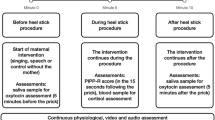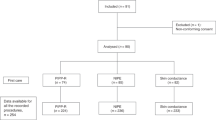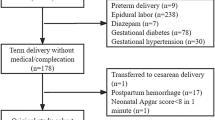Abstract
Objective:
To study whether the mode of delivery alters pain expression.
Study Design:
Full-term infants born by vaginal delivery or elective caesarean section were observed following high- and low-intensity pain stimuli, with recording of electrocardiogram, facial expression and vocalization.
Result:
Graded physiological and behavioral responses occurred, with greater responses to higher than lower intensity pain stimuli. Elevation in heart rate following both stimuli increased with time after vaginal delivery. Infants delivered by elective caesarean section showed stronger facial expressions and briefer time in vocalizations response to both interventions.
Conclusion:
Diminished responses following vaginal delivery suggest that physiological events associated with a normal delivery reduce the physiologic and sympathoadrenal activation by nociceptive mechanisms. Pain and stress reactivity appear to be inhibited during fetal life and sensory inputs during vaginal delivery may reverse this inhibition. To minimize neonatal pain, we recommend that postnatal invasive procedures to be performed shortly after vaginal birth.
This is a preview of subscription content, access via your institution
Access options
Subscribe to this journal
Receive 12 print issues and online access
$259.00 per year
only $21.58 per issue
Buy this article
- Purchase on Springer Link
- Instant access to full article PDF
Prices may be subject to local taxes which are calculated during checkout




Similar content being viewed by others
References
Derek L-J . Fundamentals of Obstretics and Gynaecology, vol. 17, Mosby: London, 1999.
Lagercrantz H . Stress, arousal, and gene activation at birth. News Physiol Sci 1996; 11: 214–218.
Lagercrantz H, Slotkin TA . The ‘stress’ of being born. Sci Am 1986; 254: 100–107.
Facchinetti F, Bagnoli F, Sardelli S, Petraglia F, De Leo V, Bracci R et al. Plasma opioids in the newborn in relation to the mode of delivery. Gynecol Obstet Invest 1986; 21: 6–11.
Raisanen I, Paatero H, Salminen K, Laatikainen T . Beta-endorphin in maternal and umbilical cord plasma at elective cesarean section and in spontaneous labor. Obstet Gynecol 1986; 67: 384–387.
Bacigalupo G, Langner K, Schmidt S, Saling E . Plasma immunoreactive beta-endorphin, ACTH and cortisol concentrations in mothers and their neonates immediately after delivery—their relationship to the duration of labor. J Perinat Med 1987; 15: 45–52.
Darwin C . The Expression of the Emotions in Man and Animals. John Murray: London, 1872.
Stevens B, Johnston C, Gibbins S . Pain assessment in neonates. In: Anand KJS, Stevens BJ, McGrath PJ (eds). Pain in Neonates, 2nd Revised and Enlarged edn, vol. 10. Elsevier Science B.V.: Amsterdam, 2000, pp 101–134.
Taddio A, Katz J, Ilersich AL, Koren G . Effect of neonatal circumcision on pain response during subsequent routine vaccination. Lancet 1997; 349: 599–603.
Grunau RV, Johnston CC, Craig KD . Neonatal facial and cry responses to invasive and non-invasive procedures. Pain 1990; 42: 295–305.
Grunau RV, Craig KD . Pain expression in neonates: facial action and cry. Pain 1987; 28: 395–410.
Stevens BJ, Johnston CC, Horton L . Factors that influence the behavioral pain responses of premature infants. Pain 1994; 59: 101–109.
Runefors P, Arnbjonsson E . A sound spectrogram analysis of children's crying after painful stimuli during the first year of life. Folia Phoniatr Logop 2005; 57: 90–95.
Michelsson K, Michelsson O . Phonation in the newborn, infant cry. Int J Pediatr Otorhinolaryngol 1999; 49 (Suppl 1): S297–S301.
Wermke K, Mende W, Manfredi C, Bruscaglioni P . Developmental aspects of infant's cry melody and formants. Med Eng Phys 2002; 24: 501–514.
Ludge W, Gips P . Microcomputer-aided studies of cry jitter uttered by newborn children based upon high-resolution analysis of fundamental frequencies. Comput Methods Programs Biomed 1989; 28: 151–156.
Lind J, Vuorenkoski V, Rosberg G, Partanen TJ, Wasz-Hockert O . Spectographic analysis of vocal response to pain stimuli in infants with Down's syndrome. Dev Med Child Neurol 1970; 12: 478–486.
Granqvist S, Hammarberg B . The correlogram: a visual display of periodicity. J Acoust Soc Am 2003; 114: 2934–2945.
Hammarberg B, Voice research and clinical needs. Folia Phoniatr Logop. 2000; 52(1–3): 93–102.
Craig KD, Hadjistavropoulos HD, Grunau RV, Whitfield MF . A comparison of two measures of facial activity during pain in the newborn child. J Pediatr Psychol 1994; 19: 305–318.
Stevens BJ, Franck LS . Assessment and management of pain in neonates. Paediatr Drugs 2001; 3: 539–558.
Franck L . A new method to quantitatively describe pain behavior in infants. Nurs Res 1986; 35: 28–31.
Johnston CC, Stevens BJ . Experience in a neonatal intensive care unit affects pain response. Pediatrics 1996; 98: 925–930.
Giannakoulopoulos X, Sepulveda W, Kourtis P, Glover V, Fisk NM . Fetal plasma cortisol and beta-endorphin response to intrauterine needling. Lancet 1994; 344: 77–81.
Teixeira JM, Glover V, Fisk NM . Acute cerebral redistribution in response to invasive procedures in the human fetus. Am J Obstet Gynecol 1999; 181: 1018–1025.
Fisk NM, Gitau R, Teixeira JM, Giannakoulopoulos X, Cameron AD, Glover VA . Effect of direct fetal opioid analgesia on fetal hormonal and hemodynamic stress response to intrauterine needling. Anesthesiology 2001; 95: 828–835.
Hagnevik K, Faxelius G, Irestedt L, Lagercrantz H, Lundell B, Persson B . Catecholamine surge and metabolic adaptation in the newborn after vaginal delivery and caesarean section. Acta Paediatr Scand 1984; 73: 602–609.
Kamibayashi T, Maze M . Clinical uses of alpha2-adrenergic agonists. Anesthesiology 2000; 93: 1345–1349.
Mogil JS, Sternberg WF, Balian H, Liebeskind JC, Sadowski B . Opioid and nonopioid swim stress-induced analgesia: a parametric analysis in mice. Physiol Behav 1996; 59: 123–132.
Stenqvist O . Inhalationsanestesi. In: Halldin MAB, Lindahl SGE (eds). Anestesi, vol. 1, Liber AB: Stockholm, 2000, pp 243–254.
Britton HL, Gronwaldt V, Britton JR . Maternal postpartum behaviors and mother-infant relationship during the first year of life. J Pediatr 2001; 138: 905–909.
Taddio A, Goldbach M, Ipp M, Stevens B, Koren G . Effect of neonatal circumcision on pain responses during vaccination in boys. Lancet 1995; 345: 291–292.
Anand KJS, Scalzo FM . Can adverse neonatal experiences alter brain development and subsequent behavior? Biol Neonate 2000; 77: 69–82.
Acknowledgements
We thank the midwives at the delivery ward at Karolinska Hospital for their collaboration and help in conducting this research, as well as the parent who allowed us to study their infant. We are also grateful to Björn Palm and Fredrik Rådesand at JORAB, Sweden, for technical support with the BIOPAC and AcqKnowledge software. Thanks to Josef Milerad for participating in designing the protocol and help draft writing of the manuscript. Thanks to Eva Björkner, Karin Nyberg and Agneta Österman for performing part of the vocalization analyses. We thank Pia Baumann, Karin Nyberg and Agneta Österman for participating with data collection at the delivery ward. Thanks also to the midwives Britt Gustavsson, Annika Denbaum, Annika Gustavsson and the speech therapists Maria Södersten, Eva Borell and Elisabet Lundström as listeners of vocalizations to the perceptual estimation. Finally, we thank Björn A Larsson in supervision of Tord Andersson, Camilla Dahlskog and Sara Grönberg for their help with part of the NFCS scoring. Thanks to the statistical support by Birgitta Böhm. Thanks to Ruth E Grunau and Ken D Craig for permission to reproduce the NFCS (Supplementary Figure S1 and Table S2), which were original published in Pain 1987; 28: 395–410. This study was supported by grants from the Freemason Society in Stockholm, The Vårdal Foundation, the Sven Jerring Foundation, FoU Östersunds Hospital, the Swedish Medical Research Council (grant 05234) and Arkansas Children's Hospital Foundation.
Author information
Authors and Affiliations
Corresponding author
Additional information
Conflict of Interest/Disclosure
There are no conflicts of interest within these people and the publication.
Supplementary Information accompanies the paper on the Journal of Perinatology website (http://www.nature.com/jp)
Rights and permissions
About this article
Cite this article
Bergqvist, L., Katz-Salamon, M., Hertegård, S. et al. Mode of delivery modulates physiological and behavioral responses to neonatal pain. J Perinatol 29, 44–50 (2009). https://doi.org/10.1038/jp.2008.129
Received:
Revised:
Accepted:
Published:
Issue Date:
DOI: https://doi.org/10.1038/jp.2008.129
Keywords
This article is cited by
-
Alteration in the time and/or mode of delivery differentially modulates early development in mice
Molecular Brain (2020)
-
Birth experience in newborn infants is associated with changes in nociceptive sensitivity
Scientific Reports (2019)
-
Is birth a critical period in the pathogenesis of autism spectrum disorders?
Nature Reviews Neuroscience (2015)
-
A 'snip' in time: what is the best age to circumcise?
BMC Pediatrics (2012)
-
La douleur chez le nouveau-né: conséquences à long terme et prise en charge
Douleur et Analgésie (2010)



